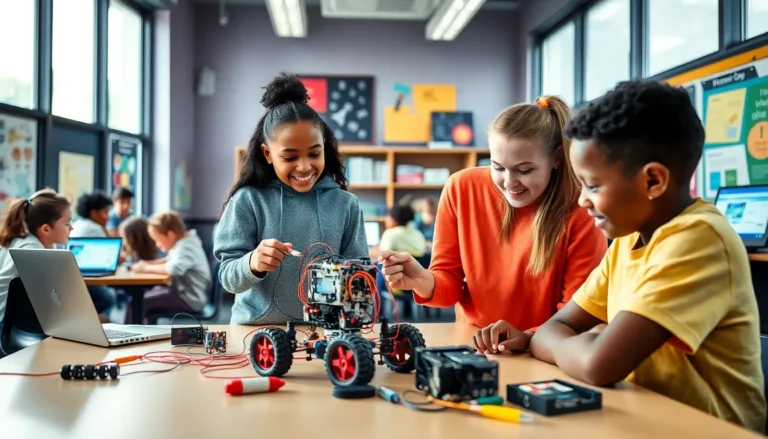Table of Contents
ToggleIn a world where technology reigns supreme, equipping kids with STEM skills isn’t just a smart move; it’s practically a superpower. Imagine your child, armed with the knowledge of science, technology, engineering, and math, ready to take on the universe—or at least the next school science fair. With the right STEM program, they won’t just learn; they’ll innovate, experiment, and maybe even create the next viral robot dance sensation.
Overview of STEM Programs for Kids
STEM programs for kids focus on integrating science, technology, engineering, and math through engaging activities. These programs create opportunities for children to explore, experiment, and develop critical thinking skills.
Definition of STEM
STEM stands for science, technology, engineering, and mathematics. This educational framework emphasizes hands-on learning and problem-solving among young learners. Encompassing a broad range of subjects, STEM encourages an interdisciplinary approach. Programs vary in scope, including coding camps, robotics workshops, and environmental science projects.
Importance of STEM Education
STEM education plays a crucial role in preparing kids for future careers. As technology advances, demand for skilled workers in these fields continues to grow. Engaging in STEM activities fosters creativity and innovation among children. These experiences enhance analytical skills, promote teamwork, and build resilience. Research indicates students involved in STEM programs perform better academically and develop a lifelong passion for learning. This foundation equips them to tackle real-world challenges effectively.
Key Components of a STEM Program
STEM programs encompass several critical components that foster children’s skills and knowledge in science, technology, engineering, and mathematics.
Science
Hands-on exploration defines science in STEM programs. Children engage in experiments that promote curiosity and inquiry. By conducting practical activities, they reinforce theoretical knowledge. Examples include plant growth projects and chemistry experiments. These activities encourage observation and analysis, key skills in scientific thinking. Students develop a deeper understanding of scientific concepts through direct experience, making learning more impactful.
Technology
Technology integration plays a crucial role in STEM education. It may involve utilizing software, apps, or digital tools to enhance learning. Through coding lessons, children learn programming languages, which develop problem-solving abilities. Robotics activities introduce concepts of automation and control systems. Such experiences offer practical applications of technology, bridging the gap between ideas and real-world solutions. Emphasizing tech empowers kids to navigate a digital world confidently.
Engineering
Engineering challenges inspire creativity and critical thinking in children. They often participate in building projects that require teamwork and resourcefulness. Constructing bridges from recycled materials illustrates fundamental engineering principles such as stability and load distribution. Students learn to design, test, and refine their creations, emphasizing the iterative process. Such hands-on projects ignite their interest in engineering careers and promote an understanding of design thinking.
Mathematics
Mathematics serves as the foundation for many STEM disciplines. Engaging tasks like data analysis and geometry puzzles sharpen children’s analytical skills. Children apply mathematical concepts to solve real-world problems, making learning relevant. Using math in projects, such as measuring materials for building prototypes, reinforces practical applications. It also enhances logical reasoning, preparing kids for advanced mathematical studies in the future. The integration of math in STEM fosters confidence and proficiency in the subject.
Benefits of STEM Programs
Engagement in STEM programs provides a multitude of advantages for children. These programs not only spur interest in science, technology, engineering, and math but also develop essential skills necessary for future success.
Critical Thinking Skills
Through participation in STEM activities, children learn to analyze situations and think critically. They explore ideas and evaluate outcomes based on evidence. Engaging in projects requires them to ask questions, gather information, and draw reasoned conclusions. This analytical mindset fosters an ability to approach problems methodically. As a result, students often excel in academic pursuits and daily decision-making scenarios.
Enhanced Creativity
Creativity flourishes in STEM environments where children experiment with various concepts. They design unique solutions to complex challenges, which allows them to think outside traditional boundaries. Exploration leads to innovative ideas that may not emerge in conventional learning settings. Consequently, kids develop a sense of confidence in their ability to create and implement new concepts. Inspiration often strikes during collaborative activities, showcasing how teamwork enhances creative thought.
Problem-Solving Abilities
STEM programs focus heavily on real-world problems, inspiring children to devise practical solutions. Engaging with challenging scenarios develops their problem-solving capabilities. Tasks often encourage iterative learning, where students refine their approaches based on trial and error. By working through obstacles, they gain resilience and adaptability. Developing these skills prepares them for future endeavors, as they learn to face challenges head-on with determination.
Choosing the Right STEM Program
Selecting an appropriate STEM program requires consideration of several factors. Assessing a child’s age and interests plays a crucial role in tailoring the experience.
Age Appropriateness
Programs designed for children vary significantly based on age. Younger learners, ages 5 to 7, benefit from interactive experiences, such as simple coding games or hands-on science activities. Kids aged 8 to 12 often enjoy more complex challenges, like robotics or engineering projects that encourage creativity and problem-solving. Teenagers, ages 13 and up, thrive in programs that delve into advanced topics, like programming languages or artificial intelligence. Parents should focus on programs that match developmental stages, promoting engagement and effective learning.
Curriculum and Activities
The curriculum shapes the quality of the learning experience. Effective STEM programs incorporate a mix of subjects to stimulate comprehensive learning. For instance, a program that combines coding with robotics allows kids to apply mathematical concepts and engineering principles. Activities should promote active participation through hands-on experiments, collaboration, and exploration. Engaging tasks, such as building models or conducting scientific experiments, foster critical thinking and creativity. Whether through coding camps or environmental science projects, programs must ensure that activities resonate with children’s interests and inspire continuous discovery.
Investing in STEM programs for kids is a crucial step toward nurturing the innovators and problem-solvers of tomorrow. These programs not only build essential skills but also ignite a passion for learning that lasts a lifetime. By engaging in hands-on activities and collaborative projects, children develop the confidence and resilience needed to tackle future challenges.
Choosing the right STEM program tailored to a child’s interests and age can significantly enhance their educational journey. As they explore the realms of science, technology, engineering, and math, kids will find themselves better prepared for a rapidly changing world. Embracing STEM education today paves the way for a brighter tomorrow.







